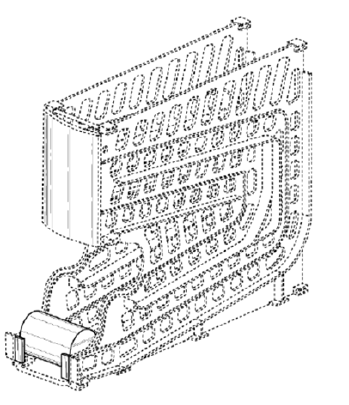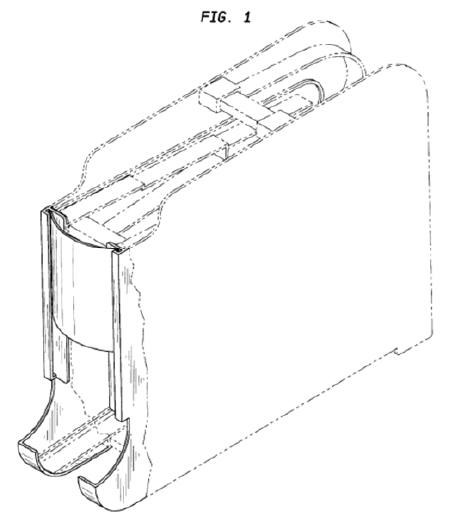
Federal Circuit Finds Campbell Soup’s “Primary” Reference to be
“M’m! M’m! Good!”
On Sept. 26, a split panel of the U.S. Court of Appeals for the Federal Circuit revived Campbell Soup Co.’s and Trinity Manufacturing’s challenge of design patents covering a display rack, ruling that the U.S. Patent Trial and Appeal Board (PTAB) wrongly excluded a prior art reference as serving as a “primary reference.”[i]
In October 2016, after they were sued for patent infringement, Campbell and Trinity filed petitions seeking inter partes review of two patents owned by Gamon Plus, Inc. The petitions alleged that the design patents would have been obvious at the time of invention in view of several prior art references.
PTAB cases involving design patents are rare. Of the many thousands of petitions filed with the PTAB since 2012, less than 1 percent have challenged a design patent. To challenge a design patent based on obviousness, one must first find a “primary” reference that is “something in existence, the design characteristics of which are basically the same as the claimed design.”[ii] Only then may the “primary” reference be modified in light of the secondary reference “to create a design that has the same overall visual appearance as the claimed design.”[iii]

Here, the two Gamon patents challenged by Campbell and Trinity claim: “The ornamental design for a gravity feed dispenser display, as shown and described.” The sole figure of the first patent is depicted below.
As can be seen, the figure shows the contour of a soup can displayed in the dispenser in solid lines. This is notable because solid lines in design patent drawings define the claimed design. The sole figure of the second patent is identical to that of the first patent, except for minor variations.
U.S. Patent No. D405,622 (Linz) was one of the “primary” references cited by Campbell and Trinity. Linz has the title “DISPLAY RACK” and it shows a number of views of its display. A figure from Linz is shown below. In contrast to the Gamon patents, Linz does not show or describe any article that it might display.

The PTAB instituted IPRs for both Gamon patents, but in its final written decisions, the PTAB found nonobviousness based on its finding that Linz failed to provide a visual impression basically the same as the patented designs. The PTAB compared a perspective figure of Linz with the figures of the Gamon patents and concluded that the differences prevented Linz from being a “primary” reference against either of the Gamon design patents.
Specifically, the PTAB explained: “The biggest difference between the designs is that Linz does not disclose a cylindrical object in its display. The claimed cylindrical object, and its spatial relationship to the label area in the [Gamon patent], is half of the scope of the design claim.”[iv] The PTAB further stated that “[a]dding a hypothetical can to Linz before comparing the designs is improper under Durling because such comparison does not consider the design ‘in existence’ and the modification has a noticeable impact on the overall design.”[v] The PTAB, therefore, held that the unmodified Linz reference does not have basically the same design characteristics as the claimed designs as a whole.
The Federal Circuit majority, however, disagreed. In a majority opinion authored by Circuit Judge Kimberly Ann Moore, the Federal Circuit vacated the Board’s conclusion that the claimed designs would not have been obvious. The court noted that the “case presents the unusual situation where we reverse the Board’s factual finding that Linz is not a proper primary reference for lack of substantial evidence support.”[vi] The court acknowledged that Linz does not show or describe any article that it might display. However, the court relied heavily on the fact that it was undisputed between the parties that the claimed designs of the Gamon patents and the design of Linz are for dispensing cans and that a can would be used in the design of Linz.[vii] The central, factual dispute with respect to Linz, according to the Federal Circuit, was “the dimensions of a can that would be used in Linz in comparison with that in the claimed designs.”[viii] But the Federal Circuit shrugged off this distinction as “ever-so-slight differences.”[ix] According to the court: “The parties do not dispute that Linz’s design is made to hold a cylindrical object in its display area. In light of these facts, the Board’s finding that Linz is not a proper primary reference is not supported by substantial evidence.”[x]
Circuit Judge Pauline Newman dissented from the ruling, saying that the PTAB had “correctly applied the law of design patent” and correctly determined that “Linz cannot serve as a primary reference.”[xi] Judge Newman wrote that the soup can was a “major design component” of the Gamon design and “cannot be deemed insubstantial.”[xii] According to Judge Newman, the majority erred by “modifying the Linz design by adding a can . . . in order to create a design more similar to the Gamon design. She noted, “Only after a primary reference is found for the design as a whole, is it appropriate to consider whether the reference design may be modified with other features, selected to match the patented design.”
Quoting In re Jennings, 182 F.2d 207 (CCPA 1950), Judge Newman wrote: “In considering patentability of a proposed design the appearance of the design must be viewed as a whole, as shown by the drawing, or drawings, and compared with something in existence—not with something that might be brought into existence by selecting individual features from prior art and combining them.”[xiii]
Click here to view the court’s decision in Campbell Soup Co. v. Gamon Plus, Inc.
[i] Campbell Soup Co. v. Gamon Plus, Inc., Appeal Nos. 2018-2019, 2018-2030 (Fed Cir. Sept. 26, 2019).
[ii] Apple, Inc. v. Samsung Elecs. Co., 678 F.3d 1314, 1329 (Fed. Cir. 2012 (internal quotation marks omitted).
[iii] Durling v. Spectrum Furniture Co., 101 F.3d 100, 103 (Fed. Cir. 1996).
[iv] Final Written Opinion, IPR2017-0091, at 33.
[v] Id. at 32 (quoting Durling, 101 F.3d at 103).
[vi] Campbell Soup Co. v. Gamon Plus, Inc., Appeal Nos. 2018-2019, 2018-2030 (Fed Cir. Sept. 26, 2019), at 9.
[vii] Id.
[viii] Id.
[ix] Id.
[x] Id. at 10 (citing Durling, 101 F.3d at 103).
[xi] Id., dissent at 1, 6.
[xii] Id., dissent at 6.
[xiii] In re Jennings, 182 F.2d 207, 208 (CCPA 1950).
Posted: October 3, 2019

